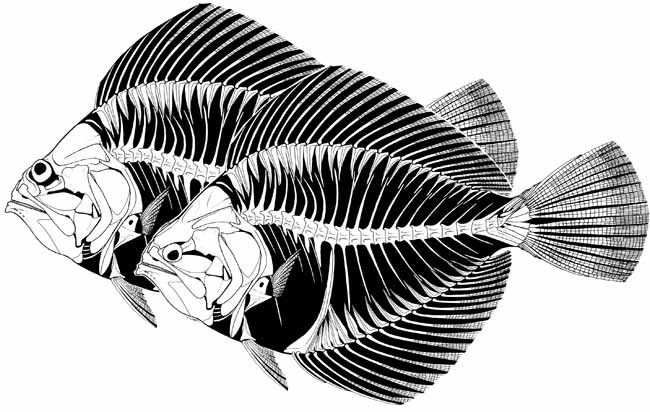Freaky Fish Was Cockeyed

A funky fish with one eye atop its head and another on its side lurked in Europe’s reef shallows about 50 million years ago, newfound transitional fossils suggest.
The fish is likely an ancestor of modern flatfish, such as sole, flounder and halibut, which have both eyes on one side of the skull, an asymmetrical facial setup that allows them to lie nearly flat along the seafloor and wait for prey.
"What we found was an intermediate stage between living flatfishes and the arrangement found in other fishes," said researcher Matt Friedman, of The Field Museum in Chicago. These fossil fishes "indicate that the evolution of the profound cranial asymmetry of extant flatfishes was gradual in nature."
The finding, detailed in the July 10 issue of the journal Nature, refutes creationists’ claims that flatfish could not have evolved gradually, Friedman said.
"The important point is that many evolutionary biologists also could not imagine how the flatfish body plan could have arisen gradually, via a series of intermediates," Friedman said.
The story "peddled for flatfishes," Friedman said, is that "they arose in a single generation, following the birth of a deformed 'hopeful monster' with both eyes on one side of the skull." The "hopeful monster" refers to the idea that some genetic mutations could give rise to a deformed "freak" that is usually at a disadvantage but every so often the oddball makes sense functionally.
Friedman examined fossil specimens of a new species that he named Heteronectes chaneti as well as Amphistium paradoxum, both found in limestone quarries in northern Italy. He also looked at specimens of another species, Amphistium altum, unearthed in Paris, France.
Sign up for the Live Science daily newsletter now
Get the world’s most fascinating discoveries delivered straight to your inbox.
The fossils had been dug up many generations ago. Friedman recently found them in museums in England, France, Italy and Austria.
"They were first figured in a publication over 200 years ago," Friedman told LiveScience. "So they have been floating around for some time now, but everyone said, 'Oh, they're symmetrical.'"
Turns out, upon closer examination, the fish are not symmetrical. Most notably, the eye orbits seem to be mid-migration. The lopsided lookers probably helped the seafloor-loving fish to peer upwards for passing prey.
The predatory fish are up to a foot (30 cm) long from nose to tail-tip and likely lived in warm shallow waters off of Europe during the Eocene Epoch when the world basked in a mild climate and animals such as whales and modern birds first evolved.
Using Darwin’s theory of evolution by means of natural selection as a guide, scientists previously have predicted a gradual transition from eyes on either side of the skull to what is seen in modern flatfishes.
With the new discovery, they now have the fossils of the intermediate flatfish forms that theory told them should exist.
- Image Gallery: Freaky Fish
- Greatest Mysteries: What Drives Evolution?
- Top 10 Useless Limbs (and Other Vestigial Organs)
Jeanna Bryner is managing editor of Scientific American. Previously she was editor in chief of Live Science and, prior to that, an editor at Scholastic's Science World magazine. Bryner has an English degree from Salisbury University, a master's degree in biogeochemistry and environmental sciences from the University of Maryland and a graduate science journalism degree from New York University. She has worked as a biologist in Florida, where she monitored wetlands and did field surveys for endangered species, including the gorgeous Florida Scrub Jay. She also received an ocean sciences journalism fellowship from the Woods Hole Oceanographic Institution. She is a firm believer that science is for everyone and that just about everything can be viewed through the lens of science.












